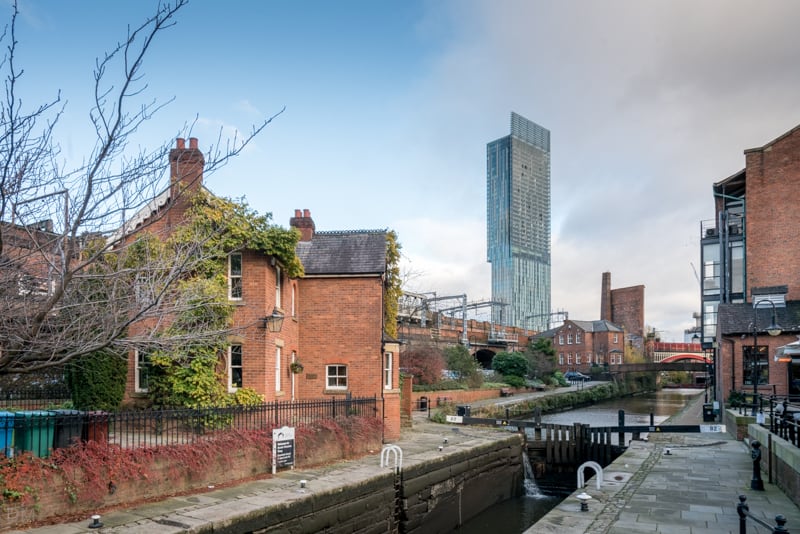Manchester Weather: A Comprehensive Guide to What to Expect

Manchester Weather, a vibrant city in the north of England, is renowned for its dynamic culture, rich history, and, let’s be honest, its weather. Whether you’re a resident, a visitor, or planning a trip, understanding the weather in Manchester is essential. Known for its unpredictability, the weather in this part of the UK can change in an instant, sometimes making it hard to prepare for the day ahead. This article will explore the many facets of Manchester’s weather, from its seasons and temperatures to its notorious rainy days.

Understanding Manches ter’s Climate
Manchester, like much of the UK, has a temperate maritime climate. This means it experiences relatively mild winters and cool summers compared to other parts of the country. However, despite its mild climate, Manchester is often perceived as cold and wet due to its frequent rainfall and the cool breeze that sweeps through the city. The city is also prone to temperature fluctuations, which can leave you needing to layer up or down throughout the day.
The climate in Manchester is heavily influenced by the surrounding Pennine mountain range. This mountainous area to the east of the city helps trap the moisture coming from the west, resulting in heavy rain at times. Moreover, the proximity to the Irish Sea contributes to its often cloudy skies and humidity. However, the weather can vary greatly within the city, especially in the surrounding suburbs or higher elevations, such as in areas like Saddleworth or the hills near Bury.
Seasons in Manchester
When it comes to seasons, Manchester doesn’t have the extreme fluctuations of temperature that are found in many other parts of the world. The city experiences four distinct seasons, each with its own characteristics. From the cold, wet winters to the sometimes damp, yet pleasant summers, each season brings its own unique feel to the city.
Winter in Manchester: A Chilly but Manageable Affair
Winter in Manchester is typically cold, but not unbearably so. From December to February, temperatures often hover around 3°C to 7°C. However, the wind chill factor can make it feel much colder, especially on blustery days. Snowfall is a rare but welcome occurrence. While the city might see a dusting of snow every few years, it’s not something to rely on for a white Christmas.
Rain is a regular feature during winter, and cloudy skies dominate the horizon for most of the season. The lack of direct sunlight can make the days feel much shorter, with daylight hours often lasting less than eight hours. If you’re visiting Manchester in winter, be sure to pack a warm jacket and waterproof gear to cope with the cold and damp conditions.
Spring: A Breath of Fresh Air
Spring in Manchester is a time of transition. The cold winter months give way to warmer temperatures, though the weather can still be quite unpredictable. From March to May, temperatures range from 8°C to 15°C, with March still being on the chillier side. Rain remains a frequent companion in spring, but there’s usually a bit more sunshine compared to the darker winter months.
April and May are when Manchester starts to bloom. The city parks and gardens, such as Heaton Park and Fletcher Moss, come alive with flowers and greenery, making it a perfect time for a stroll. However, be prepared for the occasional shower, as spring weather tends to be quite changeable.
The Famous Manchester Rain
If you ask anyone about Manchester weather, one thing is almost certain to come up: rain. Manchester’s reputation for having wet weather is well-deserved. While the city doesn’t get as much rain as some parts of the UK, its consistent drizzle and unexpected downpours are enough to give it a reputation.

Why Does It Rain So Much?
Manchester’s location in the north-west of England plays a large part in its rainy weather. As moist air from the Irish Sea moves inland, it encounters the Pennines, which cause the air to rise and cool, leading to rainfall. This is particularly true in the winter months when the city experiences its highest rainfall totals. Additionally, the prevailing westerly winds contribute to frequent showers, especially in the autumn and winter.
Although Manchester gets its fair share of rain, it’s often the light, steady drizzle rather than heavy downpours. Nonetheless, it’s a good idea to keep an umbrella or raincoat on hand while exploring the city, as the weather can change at a moment’s notice.
Summer in Manchester: Cool, but Pleasant
Summer in Manchester offers mild temperatures compared to much of Europe, making it a great time to explore the city without the oppressive heat that can affect other parts of the UK. The summer months, particularly June through August, see temperatures ranging from 15°C to 22°C. While it can occasionally get warmer, it’s rare for the temperature to rise beyond the mid-20s. This is a relief for those who prefer to avoid the intense heat waves experienced in other parts of Europe.
Despite the generally mild summer temperatures, Manchester can still experience occasional heatwaves. During these brief periods, the city may see temperatures soar to the high 20s or even low 30s. However, these instances are typically short-lived, and the city will soon return to its usual cooler summer temperatures.
The Occasional Heatwave
While it’s more common for Manchester to be cool, heatwaves do occur, especially during the summer months. The urban heat island effect, which is prevalent in large cities, can make the temperature feel higher than it is. In these conditions, it’s essential to stay hydrated and take precautions against the heat, such as wearing sunscreen and light clothing.
Despite the occasional heat, Manchester’s summer weather is a breath of fresh air after the chilly winters and unpredictable springs. It’s a great time to enjoy outdoor activities, such as attending festivals, exploring local markets, or having a picnic in one of the city’s many green spaces.

Autumn: A Time for Sweaters and Layers
Autumn in Manchester is a time when the weather starts to cool down again, and the city begins to prepare for the long winter months. September through November sees temperatures ranging from 10°C to 15°C. While autumn is not as cold as winter, the weather is typically much cooler than in summer.
The Autumn Chill
As the leaves begin to turn in Manchester’s many parks and nature reserves, the cool, crisp air becomes more noticeable. Mornings and evenings can be chilly, requiring an extra layer or sweater. Rain continues to be a part of the seasonal transition, and Manchester experiences an increase in rainfall as it heads towards winter.
The city is known for its autumnal fog, particularly in areas near the Pennines. This can create a mystical atmosphere, adding to the charm of the season. With the changing of the leaves and the cool temperatures, autumn is one of the most picturesque times to visit Manchester. Just be sure to pack appropriately, as the weather can still surprise you with a burst of rain or wind.
Monthly Breakdown of Manchester Weather
To give you a better idea of what to expect, here’s a breakdown of Manchester’s weather month by month.
January – Cold and Wet
January is the coldest month in Manchester, with average temperatures between 2°C and 5°C. Snow is possible, but rare. Expect plenty of cloudy and rainy days, so prepare for overcast skies and drizzle.
February – Still Cold
February is very similar to January in terms of temperature, with an average range of 2°C to 6°C. The rain continues, though the days gradually get longer as the month progresses.
March – Signs of Spring
By March, the temperatures begin to rise slightly, averaging between 5°C and 9°C. Rain is still frequent, but Manchester sees more sunshine as spring approaches.
April – Cool and Changeable
April is known for its unpredictable weather. You might experience sunshine, rain, and wind all in one day. Average temperatures range from 7°C to 11°C, but it’s wise to expect anything.
May – Warmer Days Ahead
May brings warmer temperatures, ranging from 10°C to 15°C. Rain is still common, but there’s more sunshine, and the city starts to feel more vibrant as flowers bloom and outdoor events ramp up.
June – Early Summer
Temperatures in June hover around 12°C to 18°C, with the occasional heatwave. Rain showers are still frequent, but they are usually brief and don’t dominate the month.
July – Warm but Comfortable
July sees average temperatures between 14°C and 22°C. Occasional heatwaves can push the mercury higher, but generally, the weather is comfortable. Rain is still common, but it’s not as oppressive as in the winter months.
August – Mild and Pleasant
August offers more of the same mild summer weather, with temperatures ranging from 15°C to 22°C. Expect a few rainy days, but most of the month is fairly dry and comfortable.
September – Cooler with More Rain
Temperatures start to cool in September, with ranges from 10°C to 17°C. Rainfall increases again as autumn approaches, but the city remains lively with festivals and outdoor activities.
October – Autumnal Transition
October is when the weather starts to feel more autumnal. Temperatures range from 8°C to 15°C, and the rain becomes more persistent. This is a month for layers and warm clothing.
November – Chilly and Wet
November is similar to October, with cooler temperatures and more rain. The average range is 4°C to 9°C. It’s a good time to start preparing for the colder weather of winter.
December – Winter Chill
By December, winter is in full swing. Expect temperatures from 2°C to 7°C, with occasional snow flurries. Rain is frequent, and daylight hours are at their lowest.
Conclusion
Manchester’s weather, though often unpredictable, is part of the city’s charm. Whether you’re visiting in the colder months, enjoying the mild summer temperatures, or witnessing the stunning changes in nature during spring and autumn, the city’s ever-changing climate is an essential part of the local experience. Be prepared for rain, and always carry a layer or two, and you’ll find that Manchester’s weather won’t stop you from enjoying all that the city has to offer.
So, whether you’re here for a weekend getaway or planning to move to the city, make sure to pack smart and embrace the ever-changing weather in Manchester. After all, a little rain or chill can never take away from the city’s vibrant spirit and energy.





